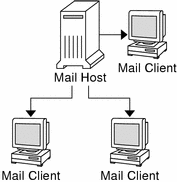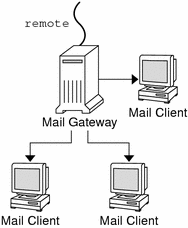Mail Services (Tasks)
This chapter describes how to set up and administer mail services. If you are not familiar with administering mail services, read Chapter 24, Mail Services (Overview) for an introduction to the components of mail services and for a description of a typical mail service configuration (as shown in Figure 24-1). The following list can help you find groups of related procedures that are covered in this chapter.
See Chapter 26, Mail Services (Reference) for a more detailed description of the components of mail services. This chapter also describes the mail service programs and files, the mail routing process, and the interactions of sendmail with name services.
See Chapter 27, What's New With Mail Services (Reference) for a description of the new features that are included in version 8.12 of sendmail, the version that is in this Solaris 9 release. You can also read about changes to mail.local, mailstats, and makemap. Chapter 27, What's New With Mail Services (Reference) also provides a description of a new maintenance command, editmap.
Mail Services Task Map
The following table refers you to task maps throughout this chapter that focus on a specific group of procedures.
Task | Description | For Instructions |
|---|---|---|
Setting up mail services | Use these procedures to set up each component of your mail service. Learn how to set up a mail server, a mail client, a mail host, a mail gateway, a virtual host, and how to use DNS with sendmail. | |
Building a sendmail configuration file | Use this procedure to modify your sendmail.cf file. See an example of how to enable domain masquerading. | |
Managing mail delivery with an alternate configuration | Use this procedure to prevent mail delivery problems that can occur if the master daemon is disabled. | "Managing Mail Delivery by Using an Alternate Configuration (Task)" |
Administering mail alias files | Use these procedures to provide aliasing on your network. Learn how to manage entries in NIS+ tables. Also, learn how to set up an NIS map, a local mail alias, a keyed map file, and a postmaster alias. | |
Administering the mail queue | Use these procedures to provide smooth queue processing. Learn how to display and move the mail queue, force mail queue processing, run a subset of the mail queue, and how to run the old mail queue. | |
Administering .forward files | Use these procedures to disable .forward files or change the search path of the .forward file. Also, learn how to permit users to use the .forward file by creating and populating /etc/shells. | |
Troubleshooting procedures and tips for mail services | Use these procedures and tips to resolve problems with your mail service. Learn how to test the mail configuration, check mail aliases, test the sendmail rule sets, verify connections to other systems, and log messages. Find out where to look for other mail diagnostic information. | "Troubleshooting Procedures and Tips for Mail Services (Task Map)" |
Resolving error messages | Use the information in this section to resolve some mail-related error messages. |
Planning Your Mail System
The following list describes some concerns that should be part of your planning process.
Determine the type of mail configuration that meets your requirements. This section describes two basic types of mail configuration and briefly lists what you need to set up each configuration. If you need to set up a new mail system or if you are expanding an existing one, you might find this section useful. "Local Mail Only" describes the first configuration type, and "Local Mail and a Remote Connection" describes the second type.
As necessary, choose the systems that are to act as mail servers, mail hosts, and mail gateways.
Make a list of all the mail clients for which you are providing service and include the location of their mailboxes. This list can help you when you are ready to create mail aliases for your users.
Decide how you plan to update aliases and forward mail messages. You might set up an aliases mailbox as a place for users to send requests for mail forwarding and for changes to their default mail alias. If your system uses NIS or NIS+, you can administer mail forwarding, rather than requiring users to manage it themselves. "Administering Mail Alias Files (Task Map)" provides a list of tasks that are related to aliasing. "Administering .forward Files (Task Map)" provides a list of tasks that are related to managing .forward files.
After you have completed the planning process, you need to set up systems on your site to perform the functions that are described in "Setting Up Mail Services (Task Map)". For other task information, refer to "Mail Services Task Map".
Local Mail Only
The simplest mail configuration, shown in Figure 25-1, is two or more workstations that are connected to one mail host. Mail is completely local. All the clients store mail on their local disks and act as mail servers. Mail addresses are parsed by using the /etc/mail/aliases files.
Figure 25-1 Local Mail Configuration

To set up this kind of mail configuration, you need the following.
The default /etc/mail/sendmail.cf file on each mail client system (no editing is required).
A server that is designated as the mail host. You can make this designation by adding mailhost.domain_name to the /etc/hosts file on the mail host. Then, if you are not running NIS or NIS+, add the mail host IP address line to the /etc/hosts file of all mail clients.
Matching /etc/mail/aliases files on any system that has a local mailbox (unless you are running NIS or NIS+).
Enough space in /var/mail on each mail client system to hold the mailboxes.
For task information on setting up your mail service, refer to "Setting Up Mail Services (Tasks)". If you are looking for a particular procedure that is related to setting up your mail service, refer to "Setting Up Mail Services (Task Map)".
Local Mail and a Remote Connection
The most common mail configuration in a small network is shown in Figure 25-2. One system includes the mail server, the mail host, and the mail gateway to the outside world. Mail is distributed by using the /etc/mail/aliases files on the mail gateway. No name service is required.
Figure 25-2 Local Mail Configuration With a UUCP Connection

In this configuration, you can assume that the mail clients mount their mail files from /var/mail on the mail host. To set up this kind of mail configuration, you need the following.
The main.cf file on the mail gateway (no editing is required if Mail Exchanger [MX] records are used).
The default /etc/mail/sendmail.cf file on each mail client system (no editing is required).
A server that is designated as the mail host. You can make this designation by adding mailhost.domain_name to the /etc/hosts file on the mail host. Then, if you are not running NIS or NIS+, add the IP address line for the mail host to the /etc/hosts file of every mail client.
Matching /etc/mail/aliases files on any system that has a local mailbox (unless you are running NIS or NIS+).
Enough space in /var/mail on the mail server to hold the client mailboxes.
For task information on setting up your mail service, refer to "Setting Up Mail Services (Tasks)". If you are looking for a particular procedure that is related to setting up your mail service, refer to "Setting Up Mail Services (Task Map)".
Setting Up Mail Services (Task Map)
The following table describes the procedures for setting up mail services.
Task | Description | For Instructions |
|---|---|---|
Setting up a mail server | Steps to enable a server to route mail | |
Setting up a mail client | Steps to enable a user to receive mail | |
Setting up a mail host | Steps to establish a mail host that can resolve email addresses | |
Setting up a mail gateway | Steps to manage communication with networks outside your domain | |
Using DNS with sendmail | Steps to enable DNS host lookups | |
Setting up a virtual host | Steps to assign more than one IP address to a host |



